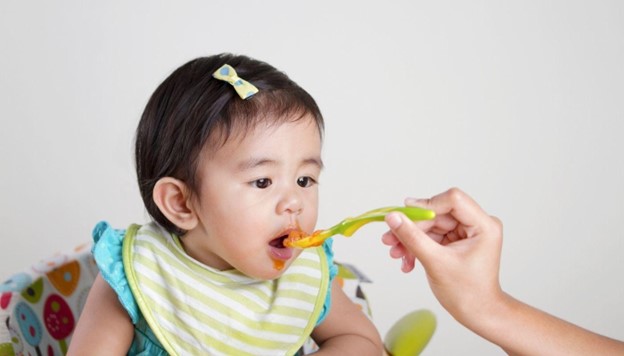Foods
What Should Be My Baby’s First Food?

Babies grow and develop fast. It seems like yesterday there was only breast milk or infant formula, and now your little one starts to show interest in solid foods. Although, you should be careful with what first food you give to your baby because his/her digestive system isn’t yet fully developed and ready to receive solid foods. So, what first food should you offer your child, and from what age? And also, how to balance your baby’s ration to provide him/her with all the needed nutrients? Here are a few tips and pieces of advice.
When is it recommended to introduce solid foods to a baby?
Usually, babies start eating their first solid food after the first 6 months of age. This is the time when they start moving a lot and need more serious nutrition. Also, their digestive system develops enough to cope with solid foods by this time. However, every child is unique and develops individually, so make sure to consult with a pediatrician before implementing any changes in your baby’s diet.
What should be my baby’s first food?
After 6 months of age, a baby can have these foods:
- porridge (cereal or made from veggies or fresh fruits)
- cooked eggs
- nuts and seeds
- soya
- fish
- cooked shellfish, etc.
When you’re giving porridge to your little one, you can either cook it on your own or buy ready-made baby products, like European baby cereal that can be prepared by adding baby formula, whole milk, or water. The assortment of baby cereals today in the market is rather wide, including porridges, milk cereals, and junior muesli. Such options make feeding your kid quick and easy, providing the needed nutrients and a healthy source of energy.
Useful tips on successful solid feeding
- Introduce solid food to your baby after the age of 6 months, unless recommended by a pediatrician otherwise.
- Breast or bottle-feed your little one before offering some solid food. When a kid is hungry, he/she can be whimmy and might refuse to take unfamiliar food.
- Give a little at first. Start with small portions and increase the amount gradually. While you’re introducing your baby to a new diet, continue feeding him/her with breast milk or baby formula so that your little treasure gets enough nutrition.
- Watch your child closely to see his/her reactions to different foods and make sure the transition from milk to solid food is comfortable for the baby.
- The spoon is important. Use a plastic spoon rather than metal at first – it’s safer, doesn’t get too hot, and the taste is more familiar (your kid probably chews his/her plastic toys). But no matter what spoon you use, give your baby time to get used to it, it might be a little awkward at the beginning, but that’s fine.
- Don’t rush your little one. Every baby reacts individually to new foods, so give your precious one time, don’t force or rush him/her. The transition should go naturally and gradually.
Conclusion
Every baby goes through the transition from first milk (whether it’s breast milk or infant formula) to second milk to solid foods. The main goal of a parent is to make this step as comfortable for a child as possible. You can cook porridge or puree from scratch or buy porridges, milk cereals, and junior muesli produced specifically to provide a baby with all the needed nutrition. Baby food manufacturers who offer baby formulas also produce balanced and healthy baby cereals and porridges. So, it depends on your decision as to what first food to give to your kid, but do this at the right age and using the right products.
-
Cloth7 years ago
10 Free Plus Size Clothing Catalogs That You Can Request Online
-
Search Engine Optimization6 years ago
List of 100 High Authority Free Guest Blogging Sites that Bring You Success on The Web
-
Search Engine Optimization6 years ago
The Secret of Link Building Strategies That Works For Every Major Search Engines
-
Blogging2 years ago
How to Start A Blog in 2022 : Step by Step Guide for Beginners
-
Cloth7 years ago
10 Free Junior Clothing Catalogs That You Can Get at Home
-
Email Marketing6 years ago
Methods To Building Your Email List from Blogging
-
Cloth7 years ago
8 Clothing Catalogs for Women That You Can Get for Free
-
Cloth6 years ago
Free Clothing Catalogs That’ll Help You Follow the Latest Fashion Trends



























